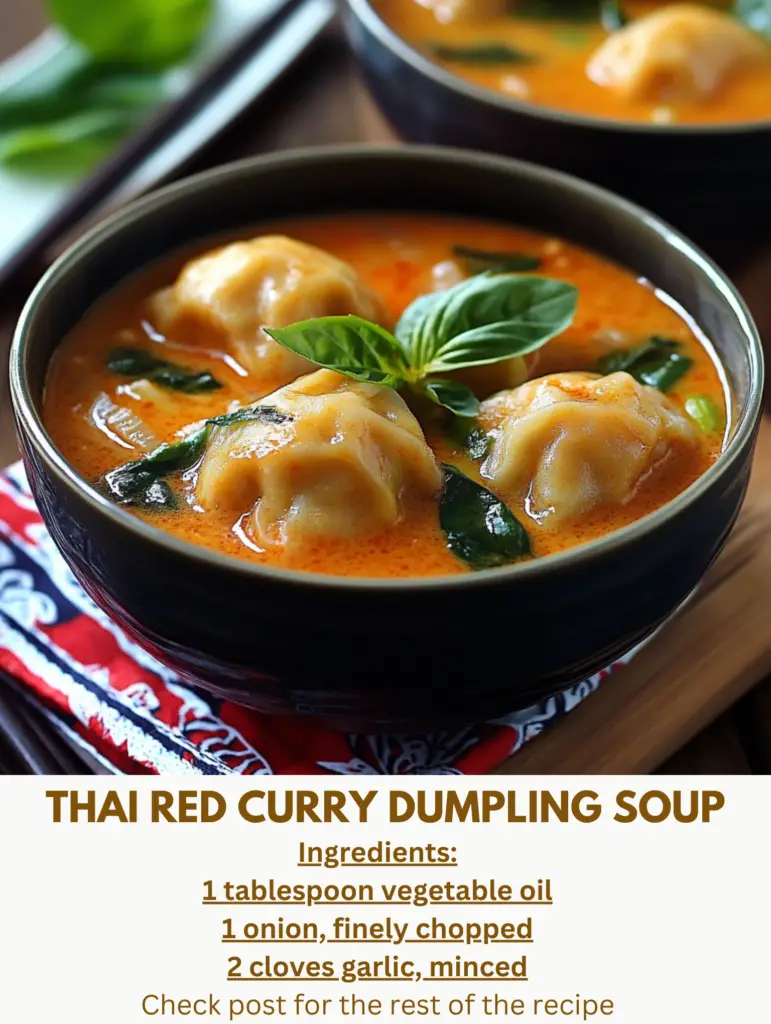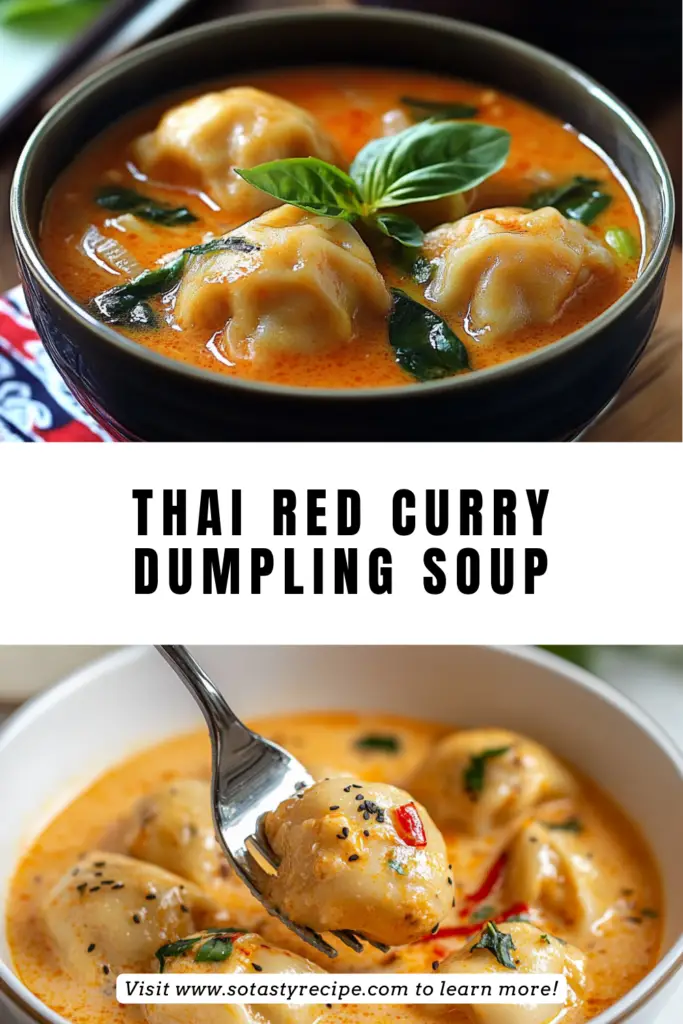Aromatic, creamy, and packed with flavor, this Thai Red Curry Dumpling Soup is your next favorite comfort meal!
Introduction
Thai cuisine is globally celebrated for its balance of flavors: spicy, sweet, sour, and savory. Among its rich offerings, Thai Red Curry Dumpling Soup stands out as a hearty dish that combines the lusciousness of coconut milk, the zest of red curry paste, and the delightful texture of dumplings. This recipe is perfect for a cozy dinner, an exotic meal prep option, or impressing your guests with something extraordinary. In this guide, we’ll explore every detail about this culinary gem, ensuring you can master it with ease.

What Is Thai Red Curry Dumpling Soup?
Thai Red Curry Dumpling Soup is a fusion dish that marries the traditional Thai red curry—a spicy and aromatic blend of red chilies, garlic, and other herbs—with the comforting allure of dumplings. The dumplings, often filled with vegetables, tofu, or shrimp, absorb the vibrant curry flavors, creating a dish that’s both nourishing and indulgent. It’s a perfect harmony of textures and tastes, ideal for spice lovers and soup enthusiasts alike.
The Origins of Thai Red Curry
Thai red curry, known as “Gaeng Phed” in Thai, has its roots in central Thailand. Traditionally made with red chilies, lemongrass, galangal, and kaffir lime leaves, it was initially a household dish prepared with locally sourced ingredients. Over time, the dish evolved, gaining global popularity for its bold flavors. Dumplings, on the other hand, are a culinary staple in various Asian cuisines, making this combination a delightful cross-cultural creation.
Seasonal and Cultural Relevance
Best Season for Thai Red Curry Dumpling Soup
This soup is best enjoyed during cooler months when its warm, creamy texture provides much-needed comfort. However, thanks to the year-round availability of its core ingredients like coconut milk and dumpling wrappers, it can be made any time of the year.
Cultural Significance
In Thailand, red curry dishes are often part of festive celebrations or family gatherings, symbolizing warmth and togetherness. Adding dumplings to this traditional dish brings a modern twist, making it suitable for diverse culinary settings.
Key Ingredients
Essential Components:
- Red Curry Paste: The heart of the dish, offering spice and aromatics.
- Coconut Milk: Provides creaminess and balances the heat of the curry.
- Dumplings: Use store-bought or homemade, filled with your choice of ingredients like vegetables or chicken.
- Vegetables: Bell peppers, carrots, and bok choy add color and nutrients.
- Herbs: Fresh cilantro and Thai basil elevate the flavor profile.
- Lime Juice: Adds a zesty kick, enhancing the overall taste.
Ingredient Substitutions
- Red Curry Paste: Substitute with green curry paste for a different flavor.
- Coconut Milk: Swap with unsweetened almond milk for a lighter version.
- Dumplings: Use gluten-free wrappers for a gluten-free option.
Nutritional Breakdown
- Calories per Serving: ~300 kcal
- Protein: ~10g
- Fats: ~15g
- Carbs: ~25g
- Fiber: ~5g
Preparation Steps
Step-by-Step Guide
- Prepare the Curry Base:
- Heat 1 tablespoon of oil in a pot.
- Sauté 2 tablespoons of red curry paste until fragrant (2-3 minutes).
- Add 1 can of coconut milk and stir well.
- Cook the Vegetables:
- Add chopped carrots, bell peppers, and bok choy.
- Simmer for 5 minutes until tender.
- Add the Dumplings:
- Gently place dumplings into the soup.
- Cook for 5-7 minutes or until they float to the surface.
- Finish with Herbs:
- Stir in fresh cilantro and Thai basil.
- Squeeze lime juice for a tangy finish.
- Serve Hot:
- Ladle into bowls and garnish with extra herbs.
Tools and Techniques
Tools You Need
- Large Pot: For cooking the soup.
- Ladle: For serving.
- Knife and Cutting Board: For chopping vegetables and herbs.
Special Techniques
- Blooming the Curry Paste: Enhances the aroma and flavor.
- Layering the Ingredients: Add ingredients in stages for balanced cooking.
Variations and Alternatives
- Protein Options: Add shrimp, tofu, or chicken.
- Vegetarian Version: Use plant-based dumplings and skip the meat.
- Spice Level: Adjust the heat by adding more or less curry paste.
Pairings and Accompaniments
- Sides: Serve with steamed jasmine rice or crispy spring rolls.
- Beverages: Pair with Thai iced tea or coconut water.
Health Benefits
- Rich in Antioxidants: Thanks to the red curry paste and fresh herbs.
- Boosts Immunity: Coconut milk and lime juice are great for overall health.
- Gluten-Free: Easy to adapt for those with gluten sensitivities.

FAQs
Why is it called Thai red curry?
The vibrant red color comes from red chilies used in the curry paste.
What is the secret to Thai curry?
Fresh ingredients like kaffir lime leaves, lemongrass, and galangal create authentic flavors.
How to thicken Thai curry soup?
Simmer the soup longer, or add a cornstarch slurry for a thicker texture.
What is Thai red curry supposed to taste like?
It’s a harmonious blend of spicy, sweet, and tangy flavors.
Suggested Recipes
For more savory recipes you can also check my friend Alicia’s blog here.

